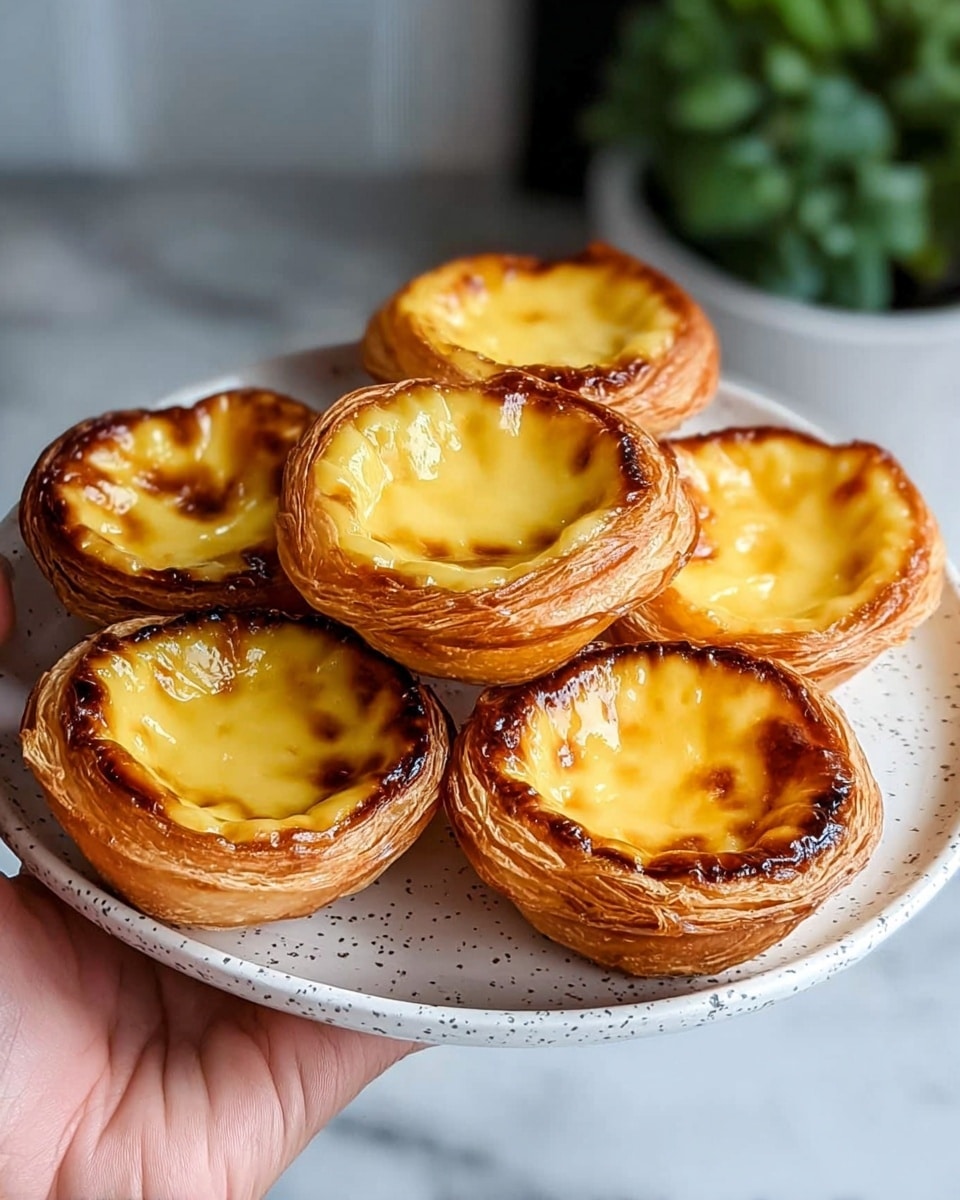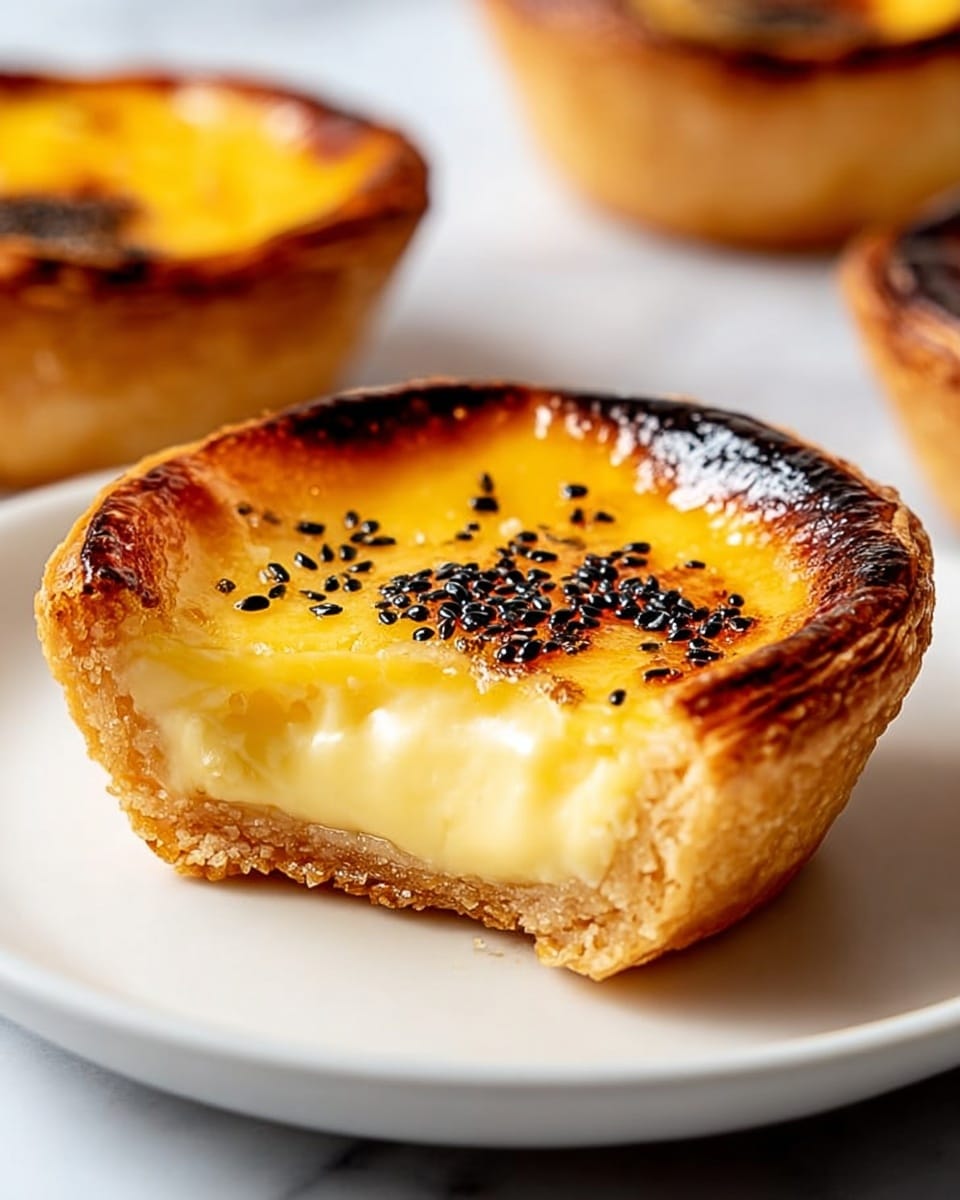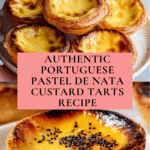Pastel de Nata (Portuguese Custard Tarts) Recipe
Introduction
Pastel de Nata are traditional Portuguese custard tarts with a flaky, buttery pastry and a creamy, caramelized custard filling. Perfectly crisp on the outside and silky inside, these tarts are a delightful treat for any time of day.

Ingredients
- 1 sheet frozen puff pastry, thawed
- Flour for dusting
- 3/4 cup (150g) granulated sugar
- 1/3 cup (40g) all-purpose flour
- 1 1/4 cups (300ml) whole milk
- 1 cinnamon stick
- Peel from 1 lemon (use a vegetable peeler to avoid the bitter white pith)
- 6 large egg yolks
- Ground cinnamon and powdered sugar for dusting (optional)
Instructions
- Step 1: Roll out the thawed puff pastry on a lightly floured surface into a thin rectangle. Roll it tightly from one short end to the other, like a jelly roll, then slice into 12 equal pieces.
- Step 2: Place each piece cut-side down into a muffin tin cup. Use your thumbs to press and stretch the dough evenly across the base and up the sides of each cup.
- Step 3: In a saucepan, whisk together the sugar, flour, and a small amount of milk to form a smooth paste. Add the remaining milk, cinnamon stick, and lemon peel. Cook over medium heat, whisking constantly, until the mixture simmers and thickens.
- Step 4: Remove the saucepan from heat and let the mixture steep for 10 minutes.
- Step 5: Whisk the egg yolks in a separate bowl. Remove the lemon peel and cinnamon stick from the milk mixture, then slowly whisk the warm milk into the egg yolks.
- Step 6: Strain the custard through a fine mesh sieve, then let it cool slightly.
- Step 7: Preheat your oven to 500°F (260°C) or the highest temperature your oven can safely reach.
- Step 8: Pour the custard into the prepared pastry cups, filling each about three-quarters full. Bake for 12–15 minutes, until the custard puffs up and the tops develop brown blister spots. Some blackened spots are traditional and add flavor.
- Step 9: Let the tarts cool in the tin for 5 minutes before transferring them to a wire rack to cool completely.
Tips & Variations
- Use a very hot oven to achieve the signature caramelized spots on top.
- For a citrus twist, try substituting orange peel for the lemon peel.
- Dust with cinnamon and powdered sugar just before serving for an authentic touch.
- If you prefer a crispier base, prebake the pastry shells for 5 minutes before adding custard.
Storage
Store leftover Pastéis de Nata in an airtight container in the refrigerator for up to 2 days. Reheat them in a hot oven (about 350°F/175°C) for 5–7 minutes to refresh the pastry before serving. Avoid microwaving to keep the crust crisp.
How to Serve

Serve this delicious recipe with your favorite sides.
FAQs
Can I use homemade puff pastry instead of store-bought?
Yes, homemade puff pastry can be used and will add extra homemade flavor, though it requires more time to prepare.
Why do some tarts have black spots on top?
Those dark spots are caramelized sugar from baking at high heat, giving a signature appearance and a slight smoky flavor which is traditional for Pastel de Nata.
PrintPastel de Nata (Portuguese Custard Tarts) Recipe
Pastel de Nata, or Portuguese Custard Tarts, are deliciously flaky puff pastry shells filled with a silky cinnamon and lemon-infused custard. This traditional recipe yields beautifully blistered, caramelized tops and creamy interiors, perfect for a classic treat served warm and optionally dusted with cinnamon and powdered sugar.
- Prep Time: 20 minutes
- Cook Time: 15 minutes
- Total Time: 35 minutes
- Yield: 12 tarts 1x
- Category: Dessert
- Method: Baking
- Cuisine: Portuguese
- Diet: Vegetarian
Ingredients
For the pastry:
- 1 sheet frozen puff pastry, thawed
- Flour for dusting
For the custard filling:
- 3/4 cup (150g) granulated sugar
- 1/3 cup (40g) all-purpose flour
- 1 1/4 cups (300ml) whole milk
- 1 cinnamon stick
- Peel from 1 lemon (use a vegetable peeler to avoid the bitter white pith)
- 6 large egg yolks
For serving (optional):
- Ground cinnamon for dusting
- Powdered sugar for dusting
Instructions
- Prepare the pastry shells: Roll out the thawed puff pastry on a lightly floured surface into a thin rectangle. Then, roll it up tightly from one short end to the other, similar to a jelly roll. Slice the rolled pastry into 12 equal pieces.
- Shape pastry in muffin tin: Place each slice cut-side down into individual cups of a muffin tin. Use your thumbs to gently press and stretch the dough evenly into the base and sides of each cup, forming the tart shells.
- Make the custard base: In a saucepan, whisk together the sugar, flour, and a small portion of the milk until a smooth paste forms. Add the remaining milk, cinnamon stick, and lemon peel. Cook over medium heat, stirring constantly, until the mixture begins to simmer and thicken slightly.
- Steep flavors: Remove the saucepan from heat and let the mixture steep for 10 minutes, allowing the cinnamon and lemon to infuse the milk.
- Combine egg yolks: While the custard mixture is steeping, whisk the egg yolks in a separate bowl. Remove the cinnamon stick and lemon peel from the milk mixture, then slowly pour the warm milk mixture into the yolks, whisking continuously to temper the eggs.
- Strain the custard: Pass the custard through a fine mesh sieve to ensure smoothness. Allow it to cool slightly before filling the tart shells.
- Preheat the oven: Set your oven to 500°F (260°C), or the highest safe temperature available for your oven, to achieve the characteristic blistered tops.
- Fill and bake: Pour the custard into each pastry shell, filling about three-quarters full. Bake for 12 to 15 minutes until the custard puffs and the tops develop traditional browned, slightly blistered spots.
- Cool and serve: Let the tarts cool in the tin for 5 minutes to set, then transfer them to a wire rack. Optionally dust with ground cinnamon and powdered sugar before serving.
Notes
- Using a high oven temperature is key to achieving the iconic caramelized and slightly charred custard tops.
- Do not discard the cinnamon stick and lemon peel after steeping; they help infuse flavor but should be removed to avoid bitterness and texture issues.
- Thoroughly pressing and stretching the pastry into the muffin tin prevents shrinking and ensures an even crust.
- The custard can be strained and cooled slightly ahead of time, but fill and bake promptly for best results.
- Serve tarts warm or at room temperature for optimal texture and flavor.
Keywords: Pastel de Nata, Portuguese Custard Tarts, Puff Pastry Custards, Traditional Portuguese Dessert, Cinnamon Lemon Custard, Caramelized Custard Tarts








